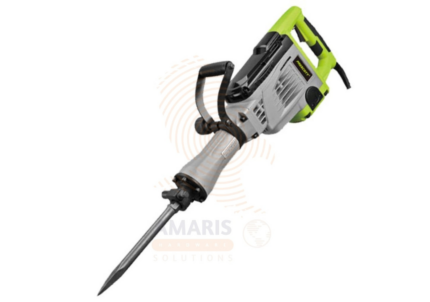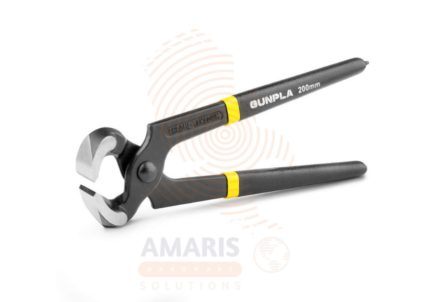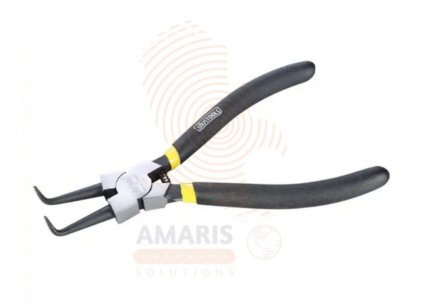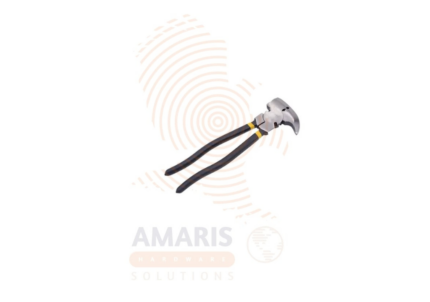
Demolition Hammer
$315.38 Original price was: $315.38.$299.61Current price is: $299.61.

Demolition Hammer Drill
$250.00 Original price was: $250.00.$237.50Current price is: $237.50.
Half Round Wood File
WhatsApp Order
PRODUCT DESCRIPTION
A half-round wood file is a type of hand tool used for shaping, smoothing, and refining wood surfaces. It typically has a flat side and a rounded side, resembling a half-circle in cross-section. The flat side is used for flat or convex surfaces, while the rounded side is suitable for concave or curved areas. These files usually have teeth or ridges along their surfaces, allowing them to efficiently remove material and create a smoother finish on wood. They are commonly employed by woodworkers, carpenters, and craftsmen for tasks such as shaping edges, refining contours, and smoothing out imperfections in wooden objects.
Description
Uses of a Half round wood file
- Shaping and Smoothing Edges: Half-round files are effective for shaping and smoothing the edges of wooden surfaces. Whether you’re rounding off sharp corners or refining the edges of a project, the file helps achieve a desired contour.
- Creating and Refining Curves: The rounded side of the file is particularly useful for creating and refining curves on wooden pieces. This makes it handy for shaping curved components of furniture or decorative items.
- Removing Material: The teeth or ridges on the file’s surface are designed to efficiently remove material. This is useful for quickly reducing the size of a wooden piece or removing excess material from a project.
- Fitting and Finishing Joints: Woodworkers often use half-round files to fine-tune the fit of joints. Whether it’s a dovetail joint, mortise and tenon , or other types of joinery, the file helps achieve a precise fit for a seamless connection.
- Smoothing Contours: When working on intricate or detailed wooden projects, a half-round file is valuable for smoothing out contours and refining the overall surface finish.
- Rasping and Rough Shaping: The file is capable of aggressive material removal, making it suitable for rasping and rough shaping tasks. This is particularly useful in the early stages of a woodworking project.
- Cabinetmaking: In cabinetmaking and carpentry, half-round files are commonly used for tasks such as shaping cabinet components, rounding edges of panels, and refining the details of wooden furniture.
- Sculpting and Carving: Woodworkers and artisans engaged in sculpting or carving projects can use a half-round file to shape and refine intricate details in their work.
- Tool Maintenance: Woodworking tools, such as chisels and gouges, may require occasional maintenance. A half-round file can be used to sharpen and maintain the cutting edges of these tools.
- Repair and Restoration: In woodworking repair and restoration projects, a half-round file can be instrumental in shaping replacement parts, smoothing out damaged areas, and achieving a seamless integration of new wood with existing structures.
SAFETY HANDLING PRECAUTIONS
Safety measures and precautions
- Wear Personal Protective Equipment (PPE):
- Eye Protection: Always wear safety glasses or goggles to protect your eyes from flying wood particles and debris.
- Hand Protection: Consider wearing work gloves to protect your hands from splinters and abrasions.
- Secure Workpiece:
- Ensure that the workpiece is securely clamped or held in place. This helps prevent the material from moving unexpectedly, reducing the risk of accidents.
- Proper Grip:
- Hold the file with a firm grip, keeping your hand away from the working end. This ensures better control and reduces the risk of slippage.
- Body Position:
- Stand or sit in a stable position to maintain balance while filing. Avoid awkward or unstable postures that may lead to accidents.
- File Orientation:
- Pay attention to the orientation of the file. Ensure that it is moving away from your body and not towards it. This minimizes the risk of injury in case the file slips.
- File Maintenance:
- Keep the file clean and in good condition. Inspect it regularly for any damage or dullness. A well-maintained file is safer and more effective.
- Work in a Well-Lit Area:
- Adequate lighting in your workspace helps you see the workpiece and the file clearly, reducing the chances of errors and accidents.
- Control Pressure:
- Use controlled and steady pressure when filing. Avoid excessive force, as it may lead to loss of control and increase the risk of injury.
- File Away from Your Body:
- Always file in the direction away from your body. This minimizes the risk of injury if the file slips or if there's an unexpected movement.
- Take Breaks:
- If working for an extended period, take regular breaks to prevent fatigue. Fatigue can lead to loss of concentration and an increased risk of accidents.
- Be Mindful of Surroundings:
- Be aware of your surroundings, especially if working in a shared workspace. Communicate with others to avoid collisions or interference.
- Use the Right File for the Job:
- Ensure you are using the appropriate type and size of file for your specific woodworking task. Using the right tool reduces the risk of accidents and improves efficiency.
- Education and Training:
- If you're new to using hand tools, seek guidance from experienced individuals or take a woodworking safety course to learn proper techniques and precautions.
Related products
C Clamp Locking Pliers
A C clamp locking pliers, often simply referred to as locking pliers or Vise-Grips (a popular brand name), is a versatile hand tool designed for gripping, clamping, and holding objects securely. The tool features an adjustable locking mechanism that allows it to maintain a constant grip force on the object, freeing the user's hands for other tasks. The jaws of the pliers are shaped like a C-clamp, providing a strong and secure grip on various shapes and sizes of objects. This makes C clamp locking pliers particularly useful in situations where a stable hold is required, such as in woodworking, metalworking, automotive repair, and general DIY applications.
Carpenter’s Pincers
Carpenter's pincers, also known as end-cutting pliers or end nippers, are a type of hand tool used in carpentry and woodworking. They typically have sharp, pointed jaws that come together in a cutting edge at the tips. These pincers are designed for gripping, cutting, and pulling materials such as nails, wires, or small objects in woodworking applications. The jaws are angled to provide leverage and facilitate precise cutting or gripping in tight spaces. Carpenter's pincers are a versatile tool commonly found in a carpenter's toolkit for various tasks related to shaping and assembling wood.
Countersink Drill Set
A countersink drill set typically refers to a collection of six tools designed for countersinking operations in woodworking or metalworking. Each set usually includes six individual countersink drills with varying sizes or angles. Countersinking is a process that involves creating a conical hole in a material, allowing the head of a screw or bolt to sit flush with or below the surface. These drill sets are essential for achieving a professional finish in various applications where a smooth and even surface is desired, such as in carpentry, metal fabrication, or DIY projects.
Electrician Screwdriver Set
An electrician screwdriver set typically refers to a collection of six individual screwdrivers specifically designed for use by electricians. These screwdriver sets often include a variety of sizes and types of screwdrivers that are commonly used in electrical work. The set may include Phillips and slotted screwdrivers in different sizes, as well as insulated handles to provide electrical safety when working on live circuits. The goal of such a set is to provide electricians with a versatile and comprehensive tool kit to tackle various tasks in the field of electrical work.
External Circlip Pliers Bent
External circlip pliers – bent refer to a specialized hand tool designed for the installation and removal of external circlips. A circlip, also known as a retaining ring or snap ring, is a type of fastener or retaining device that fits into a groove on a cylindrical object, such as a shaft or a bore. External circlips are positioned on the outside of the shaft or bore.
The term "bent" in the context of external circlip pliers describes the shape of the tool. These pliers typically have angled or bent tips that allow for easier access to the external circlip, especially in tight or confined spaces. The bent design helps the user reach and manipulate the circlip more effectively, providing improved maneuverability during installation or removal.
Fence Pliers
Fence pliers are a specialized type of pliers designed for use in fencing and related tasks. They typically feature a combination of functions that make them well-suited for various activities involved in installing, repairing, and maintaining fences. These pliers often include features such as a gripping jaw, wire-cutting blades, a staple puller, and sometimes a hammerhead. The design of fence pliers aims to provide versatility and convenience for professionals or DIY enthusiasts working with fencing materials, wires, and staples.
Flat Cold Chisel with Guard
A Flat Cold Chisel with Guard is a hand tool designed for cutting, shaping, or removing metal by striking it with a hammer. The chisel has a flat, elongated metal blade with a sharp cutting edge at one end. The guard, often made of metal or another protective material, is positioned along the sides of the blade to enhance safety during use. This guard helps prevent accidental injuries by shielding the user's hand from direct contact with the sharp edge and also provides stability to the chisel during striking. The flat cold chisel with a guard is commonly used in metalworking and construction applications.
Folding Saw
PRODUCT DESCRIPTION
A folding saw is a compact and portable cutting tool designed for outdoor and survival activities. It typically features a serrated blade that folds into a handle, allowing for safe and convenient storage when not in use. Folding saws are commonly used for cutting through wood, branches, or other vegetation during camping, hiking, and various outdoor adventures. The folding design enhances portability and safety, making it a versatile tool for enthusiasts and professionals alike.


 Acrylic Sealants
Acrylic Sealants Construction Adhesives
Construction Adhesives Double-Sided Tape
Double-Sided Tape Duct Tape
Duct Tape Electrical Tape
Electrical Tape Epoxy & Resins
Epoxy & Resins Masking Tape
Masking Tape
 Automotive Wrenches & Socket Sets
Automotive Wrenches & Socket Sets Battery Chargers & Jump Starters
Battery Chargers & Jump Starters Car Jacks & Stands
Car Jacks & Stands Car Wash & Detailing Products
Car Wash & Detailing Products Diagnostic Tools
Diagnostic Tools Tire Inflators
Tire Inflators Vehicle Lighting
Vehicle Lighting Oil & Lubricants
Oil & Lubricants
 Adhesives & Sealants
Adhesives & Sealants Bricks & Blocks
Bricks & Blocks Cement & Concrete
Cement & Concrete Drywall & Plaster
Drywall & Plaster Flooring (Tiles, Wood, Laminate)
Flooring (Tiles, Wood, Laminate) Lumber & Plywood
Lumber & Plywood Paints, Primers & Coatings
Paints, Primers & Coatings Insulation Materials
Insulation Materials Roofing Materials
Roofing Materials
 Circuit Breakers
Circuit Breakers Electrical Cables & Wires
Electrical Cables & Wires Switches & Sockets
Switches & Sockets Fuses & Relays
Fuses & Relays Connectors & Terminals
Connectors & Terminals Electrical Boxes & Panels
Electrical Boxes & Panels Conduit & Fittings
Conduit & Fittings Lighting Fixtures & Bulbs
Lighting Fixtures & Bulbs Extension Cords & Power Strips
Extension Cords & Power Strips
 Anchors
Anchors Bolts
Bolts Clips & Clamps
Clips & Clamps Screws
Screws Nuts
Nuts Washers
Washers Rivets
Rivets Nails
Nails Threaded Rods
Threaded Rods
 Hammers
Hammers Measuring Tools (Tapes, Levels, Calipers)
Measuring Tools (Tapes, Levels, Calipers) Screwdrivers
Screwdrivers Pliers & Cutters
Pliers & Cutters Saws & Blades
Saws & Blades Chisels & Punches
Chisels & Punches Allen Keys & Hex Keys
Allen Keys & Hex Keys Ratchets & Socket Sets
Ratchets & Socket Sets Wrenches & Spanners
Wrenches & Spanners
 Power Tool Accessories (Blades, Bits, Discs)
Power Tool Accessories (Blades, Bits, Discs) Rotary Tools
Rotary Tools Saws (Circular, Jigsaw, Reciprocating)
Saws (Circular, Jigsaw, Reciprocating) Drills & Drivers
Drills & Drivers Grinders & Sanders
Grinders & Sanders Heat Guns
Heat Guns Nail Guns
Nail Guns Impact Wrenches
Impact Wrenches Batteries & Chargers
Batteries & Chargers
 Pipes & Fittings (PVC, Copper, PEX)
Pipes & Fittings (PVC, Copper, PEX) Plumbing Tools
Plumbing Tools Pumps & Motors
Pumps & Motors Sealants & Adhesives for Plumbing
Sealants & Adhesives for Plumbing Valves & Taps
Valves & Taps Water Heaters
Water Heaters Drainage Systems
Drainage Systems Faucets & Fixtures
Faucets & Fixtures Hoses & Tubing
Hoses & Tubing
 Hinges & Latches
Hinges & Latches Hooks & Brackets
Hooks & Brackets Window Hardware
Window Hardware Chains & Cables
Chains & Cables Casters & Wheels
Casters & Wheels Shelving & Storage Systems
Shelving & Storage Systems Door Handles & Locks
Door Handles & Locks Drawer Slides & Cabinet Hardware
Drawer Slides & Cabinet Hardware
 Personal Protective Equipment (PPE)
Personal Protective Equipment (PPE) Respirators & Masks
Respirators & Masks Safety Glasses
Safety Glasses Safes
Safes Security Cameras
Security Cameras Gloves
Gloves Helmets
Helmets Ear Protection
Ear Protection Fire Safety Equipment
Fire Safety Equipment Locks & Padlocks
Locks & Padlocks Motion Sensors & Alarms
Motion Sensors & Alarms
 Garden Fencing
Garden Fencing Garden Furniture Hardware
Garden Furniture Hardware Lawn Mowers
Lawn Mowers Trimmers & Edgers
Trimmers & Edgers Shovels & Spades
Shovels & Spades Rakes & Hoes
Rakes & Hoes Pruning Shears & Loppers
Pruning Shears & Loppers Watering Systems (Hoses, Sprinklers, Nozzles)
Watering Systems (Hoses, Sprinklers, Nozzles)
 Interior Paints
Interior Paints Paint Brushes & Rollers
Paint Brushes & Rollers Paint Strippers & Thinners
Paint Strippers & Thinners Paint Trays & Accessories
Paint Trays & Accessories Exterior Paints
Exterior Paints Spray Paints
Spray Paints Primers & Undercoats
Primers & Undercoats Varnishes & Stains
Varnishes & Stains
 Gaskets & Seals
Gaskets & Seals Hydraulic Fittings
Hydraulic Fittings Industrial Fasteners
Industrial Fasteners Industrial Hoses
Industrial Hoses Lubricants & Greases
Lubricants & Greases Metal Sheets & Bars
Metal Sheets & Bars Bearings & Bushings
Bearings & Bushings Belts & Pulleys
Belts & Pulleys
 HVAC Filters
HVAC Filters Insulation for HVAC
Insulation for HVAC Air Conditioners
Air Conditioners Refrigerants
Refrigerants Ventilation Ducts & Fittings
Ventilation Ducts & Fittings Thermostats & Controllers
Thermostats & Controllers Fans & Blowers
Fans & Blowers
 Pegboards & Hooks
Pegboards & Hooks Shelving Units
Shelving Units Storage Bins & Containers
Storage Bins & Containers Toolboxes & Tool Chests
Toolboxes & Tool Chests Workbenches
Workbenches Drawer Organizers
Drawer Organizers Labeling Supplies
Labeling Supplies
 Welding Accessories (Clamps, Brushes)
Welding Accessories (Clamps, Brushes) Welding Electrodes & Rods
Welding Electrodes & Rods Welding Helmets & Gloves
Welding Helmets & Gloves Welding Machines
Welding Machines Soldering Irons & Stations
Soldering Irons & Stations Flux & Solder Wire
Flux & Solder Wire
 Generator Accessories
Generator Accessories Inverters
Inverters Portable Generators
Portable Generators Power Inverters
Power Inverters Transfer Switches
Transfer Switches Diesel & Gasoline Generators
Diesel & Gasoline Generators
 Transport Equipment: Carts, Dollies, and Hand Trucks
Transport Equipment: Carts, Dollies, and Hand Trucks Storage Solutions: Pallets, Racks, and Containers
Storage Solutions: Pallets, Racks, and Containers Lifting Equipment: Hoists, Cranes, and Jacks
Lifting Equipment: Hoists, Cranes, and Jacks Conveyors and Accessories: Belts and Rollers
Conveyors and Accessories: Belts and Rollers










